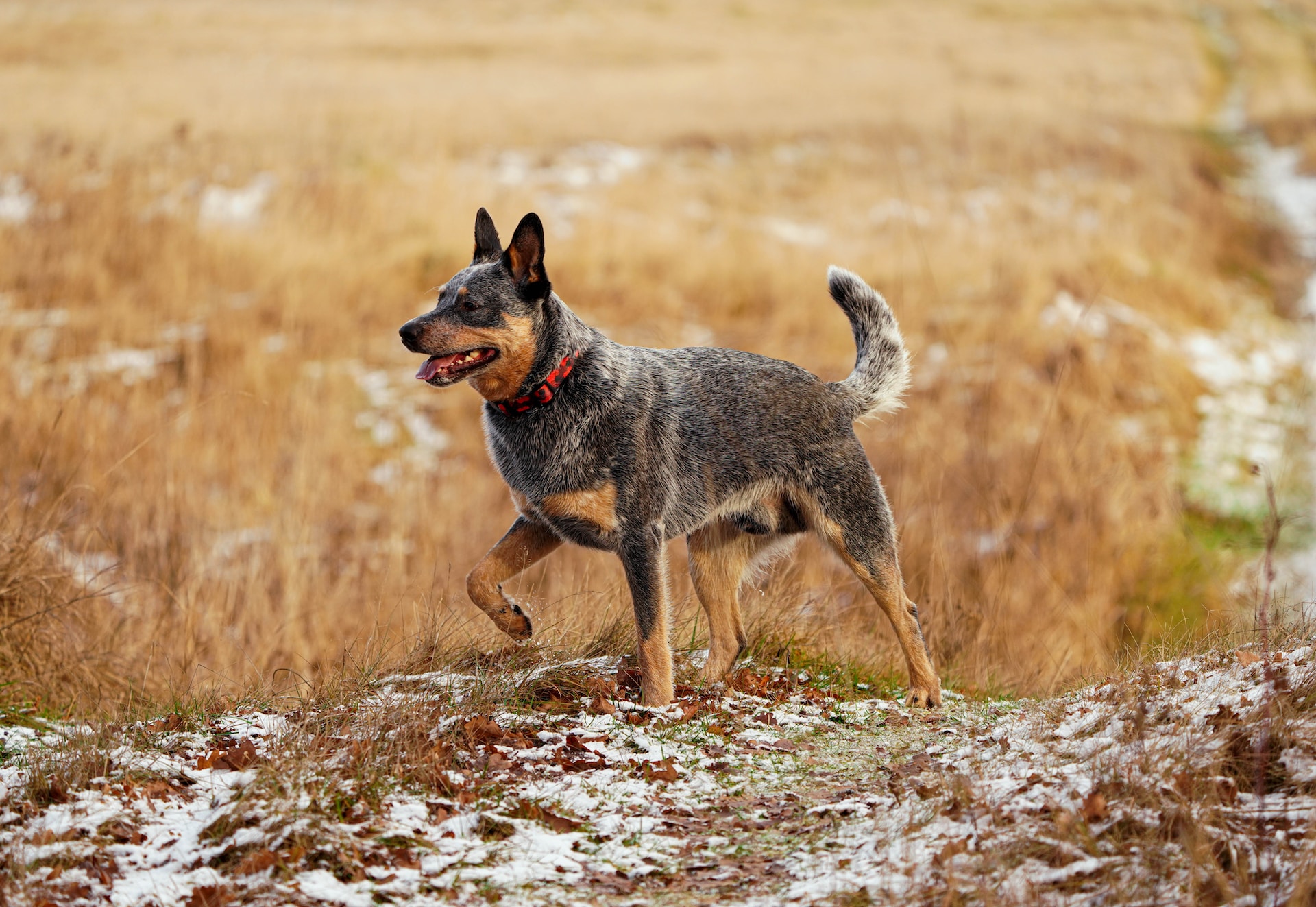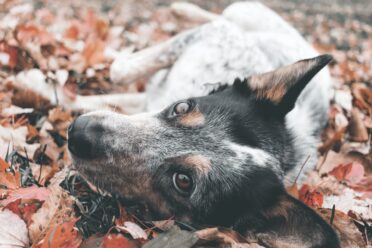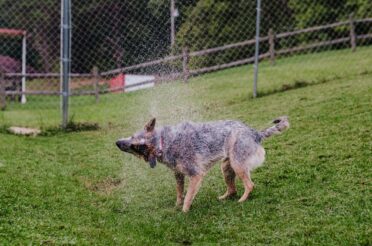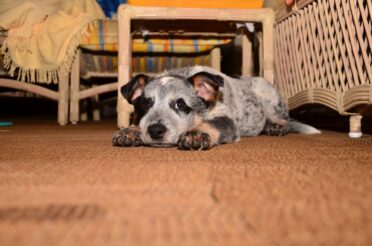This page contains affiliate links. We may earn money or products from the companies mentioned in this post through our independently chosen links, which earn us a commission. Learn More

The blue heeler or the Queensland heeler also known as the Australian cattle dog (ACD), is a medium-sized robust, or sturdy dog breed that was developed originally in Australia.
The height of the blue heeler ranges between 17 to 20 inches with a hard-muscled frame having agility and strength. Its compact double-layered thick coat underlies the body while a short weather-resistant outlining covers the overcoat.
How did the blue heeler breed begin?
The blue heeler was historically bred to herd cattle by the Australian pioneers during the 19th century. The ACD breed is largely acknowledged for using its skills to help farmers efficiently expand the beef industry in Australia.
After various breeding and cross-breeding, the ranchers developed a strong and stout canine breed that could bear the harsh climates of Australia. From England, the import of dogs was made in Australia, where English dogs were crossed with native Australian dingo breeds and the ancestors of the blue heeler were produced that we know today.
The first registration of Australian Cattle Dogs was accepted in May 1980 by the American Kennel Club. In September the breed became appropriate for a show in the Working Group, and in 1983 the breed was transferred to the Herding Group of dogs.
Are blue heelers workable and loyal?
The blue heelers are very hard-working, genius, and loyal to their owners. They were originally taken as herders to work on farms with cattle and this is still practiced as a part of their job. They are fiercely kind of loyal or known as true-blue loyal, ever alert and suspicious of strangers, and this loyalty has even made them better workers.
It is very interesting to know that they can even work in the absence of their owners. So in case you do not want to work, they will work efficiently like searching or figuring out puzzles or rescuing toys.
They have boundless energy and pliable gait activity, making them excellent field runners. If blue heelers are not given any challenge, they become bored and easily get into mischief. Therefore, it is recommended that owners should indulge them in some activities so they are active and can complete their tasks. Other than this, owners should work with their dogs, and ensure the regular exercise of their pets to keep them both physically and mentally fit.
What are the behavioral characteristics of the Australian Cattle Dog?

Despite having an untiring work ethic, blue heelers are known as “shadow dogs” as they are intensely devoted to their owners and do not want to get separated from their possessors.
The ACD is an extremely active dog that happily becomes your partner during running or hiking. They become friendly with their family but often wary around strangers. If these dogs are well trained, they socialize themselves with other household dogs and cats friendly to them and make strong bonding beneficial for them.
They are highly affectionate and friendly, with medium pet-friendly and kid-friendly levels. Their intelligence level is high and needs high energy, trainability, playfulness, and exercise. The amount of shedding and tendency to bark is medium in them.
What are the general body features of blue heelers?
The blue heeler does have some characteristic features of body shape, size, and color which make it distinguishable among other dog breeds.
How does the blue heeler look?
Appearance
The Blue heeler or Australian cattle dog has blue body color with a black mask and tan markings on the whole body. It appears to be agile and strong because it is a solid, muscular, compact canine.
Face and head
It has strong cheeks and a deep, and powerful nose of medium length. Its broad cranium compresses to a clear stop in between eyes. The ears of bleu heeler are lanced, small to medium-sized, and spread widely. The inside of the ears is covered in hair. The dark, oval eyes have an alert, discerning gaze.
Legs and feet
It has round and arched feet, with short, robust nails and toes, and the front legs are straight and parallel.
Even when bred for companionship or competition, the Australian Cattle Dog is expected to have well-conditioned muscles. The breed standard specifies that every dog’s appearance should be balanced and symmetrical. It shouldn’t appear either delicate or heavy, as both traits reduce the agility and endurance required of a working dog. The shoulders and neck of blue heelers are also muscular and strong.
What is the body Size of a blue heeler?
Blue heeler’s body length (from breastbone to buttock region) is more than their height from ground to withers. Male blue heelers are taller than females whereas the body weight of a healthy blue heeler dog ranges from 18 – 25 Kg (40 to 55 pounds).
What is the body coat color of blue heelers?
The puppy blue heelers have different body coat color which changes when they mature.
Puppy blue heeler body color
Puppy has white coat color with red hairs that start as spots and increase in number with maturation.
Adult blue heeler body color
Queensland Heeler adults have two generally acceptable basic coat colors which are blue and red while cream or chocolate colors depict the fault in body coat color. Blue heeler has variable body coat colors which are:
- Blue
- Blue speckled with tan on the chest and legs
- Blue molted and a black mask or patch on the head from both sides
- Red with solid red markings on the body with a red or brown mask (patch) on the head from one or both sides and sometimes on the whole body
Variability in the adult body coat color is due to red or black hairs closely interspaced. This coloration is linked with genes as well as with health problems too. Many breeds depict the presence of variable colors on white body coats associated with the impact of genes that control the shape, size, and density of coloration.
Blue dogs might have tan on their jaws, throat, eyebrows, and the area between their legs and the breast.
In Queensland heelers there is a double coat; the undercoat is short, dense, and fine, and the outer guard hairs are short, straight, and protective, maintaining the elements of the dog’s skin.
Are there particular features of the blue heeler’s tail?
According to the breed criteria of the American, Australian, and Canadian kennel clubs The Australian Cattle Dog or blue heeler has a:
- Natural
- Long
- Undocked tail
- White tip at the base of the tail, which is frequently uniform in color
- The tail is somewhat low placed and follows the back’s slope
Even though an aroused dog may lift the tail higher, it should hang in a little curve while at rest. A substantial amount of brush should cover the tail.
On working stock, tails may occasionally be docked in the US. Australia does not dock its animals’ tails, which helps them move more quickly and with greater agility. A square-bodied blue heeler with a naturally “bobbed” tail is called an Australian Stumpy Tail Cattle Dog; the Australian Cattle Dog is a different breed.
What should I know about the temperament of the blue heeler?

Blue heeler dogs are energetic, sharp, and intelligent dogs. The breed is ranked as one of the most intelligent ones by command trainability in Stanley Coren’s The Intelligence of Dogs, where the blue heelers are ranked 10th in intelligence.
A non-working Cattle Dog could take part in sports, learn tricks, or do other efforts that challenge the body and intellect because this breed needs a lot of exercise, company, and a job to complete.
What is the social behavior of Australian cattle dogs?
The Australian Cattle Dog behaves differently with different people and other dogs.
Behavior with family
It is a loving and entertaining pet when at home. As a family companion, it may be socialized to be accustomed to various people from a younger age. It works well with older, respectful kids, but it will bite at people’s heels and hurt them, especially tiny kids who run and squeal. Puppies ought to know that being around people is enjoyable and that following directions from a person is rewarding by the time they are weaned.
Behavior with owner
This breed can form a close attachment with its owner that makes the dog feel protected towards the owner, which usually leads to the dog never leaves the owner’s side. Although it can react quickly to its owners’ emotions and may defend even without waiting for a command, the Australian Cattle Dog may be one of the kindest companions.
Behavior with strangers
It is wary of strangers and inherently cautious in novel circumstances. When taught for this function, its attitude towards strangers makes it an ideal guard dog.
Behavior with other canines
It reacts well to well-known canines, but establishing a pecking order might lead to hostility when other dogs are around. It is not a breed that cohabitates with other dogs in a group.
The bark of Australian cattle dog
Australian Cattle Dogs typically work quietly however; they bark in an emergency or to get attention. Its bark is distinctively loud and high-pitched. Although studies have shown that blue heelers increase their vocalization when grown in a busy environment, barking can also indicate boredom or displeasure
How can you take care of blue heeler health: A Guide
The Australian Cattle dog gets tired and becomes a destructive type of dog if it does not get an outlet or exit for its energy and starts crushing furniture or shoes. The blue heeler feels happy in a home with a fenced boundary or a sheltered property to run in. However, this breed does not want to stay alone for a long time in a small area. So, it is recommended by animal practitioners not to leave your pet alone but rather accompany your pets along with you when going for a walk, hike, or a trip to the riverside.
Exercise or physical activity for the blue heeler
Exercise or physical activity is a very significant part of a blue heeler’s lifespan. As they are from a hardworking legacy, this breed demands at least 30 minutes of muscular activity or regular exercise a day.
Physical exercise along with multiple games will make your blue heeler more active. They also need mental stimulation for their healthy activity, so engage your dogs in different kinds of puzzles, tug toys, and chomps and help your dogs stay satisfied.
Entertain your dog with a puzzle-dispensed treat or a peanut butter-filled rubber toy or another entertaining feast. Play with your dog and engage him in different types of exercises so he may feel more energetic and fulfill his duty more efficiently.
Grooming of the blue heeler
The Queensland heeler does not need high care and protection. Even little maintenance and care are necessary and make the dogs good in health. Monthly activities include
- Trimming nails once a month
- Brushing the teeth as per requirement
- Bathing according to the weather situation
- Ear cleaning on time for proper well-being
This breed does not possess a doggy odor or excessive salivation but rather a little drooling of saliva.
The two-layered skin coating does not require extra care. However, when shedding season (spring season) arrives, excess shedding happens and dogs remove their winter coat. During this period, it is necessary to comb your blue heeler regularly.
What do I need to know about the training of my Australian cattle dog?
The Australian Cattle dogs can simply be trained for multiple jobs because they are energetic and intelligent and perform any task easily. They can flock to everything efficiently either the cattle, children, or any other pet herd that moves in their vicinity. That is the reason blue heelers are trained early to make them socialize and understand the behavior of owners and strangers so they may supervise the herd more effectively.
If the early training of blue heelers is neglected, they may bark or bite at the running children, or play with the other animals on the farm roughly.
The blue heelers do extremely well at canine competitions such as flyball, agility or herding contests, or conformity trials. In addition to this, the time taken to training and social interaction with your pet will be a good way to not only stimulate their mentality but also the further development of interaction bond between you and your pal.
What are the common health problems associated with Blue Heelers?

The Queensland Heelers are powerful and athletic pets, but their joints and ligaments can undergo some muscular wear and tear. Any signs of hobbling or limping in the legs should be checked out by a veterinarian.
Some common ailments in blue heelers are
- Canine hip dysplasia
- Progressive retinal atrophy
- Genetic deafness
If your blue heeler is suffering from any of this pathology, the dog must be treated by an experienced veterinarian.
Diet and Nutrition of the Queensland Heelers
As you know Blue heelers are very active dogs and due to high physical activity as herders, they also need proper diet and nutrition.
The owners must ensure that their bleu heelers are taking enough calories to meet their lifestyle activities. Commercially available dog feeds have balanced calories of nutrients for dogs that are working as companion animals.
The ACDs that are working for hours either sprinting or running, must offer a good diet for better performance that meets their specific needs for efficiency. As the dogs become older, the owner may give canned food or soaked food to the dogs as it will easily be engulfed by the old dogs having fewer teeth.
As these dogs are active so we should promote a healthy diet for healthy joints like glucosamine and chondroitin or also add a joint supplement to the feed for a healthy outcome.

Leave a Reply